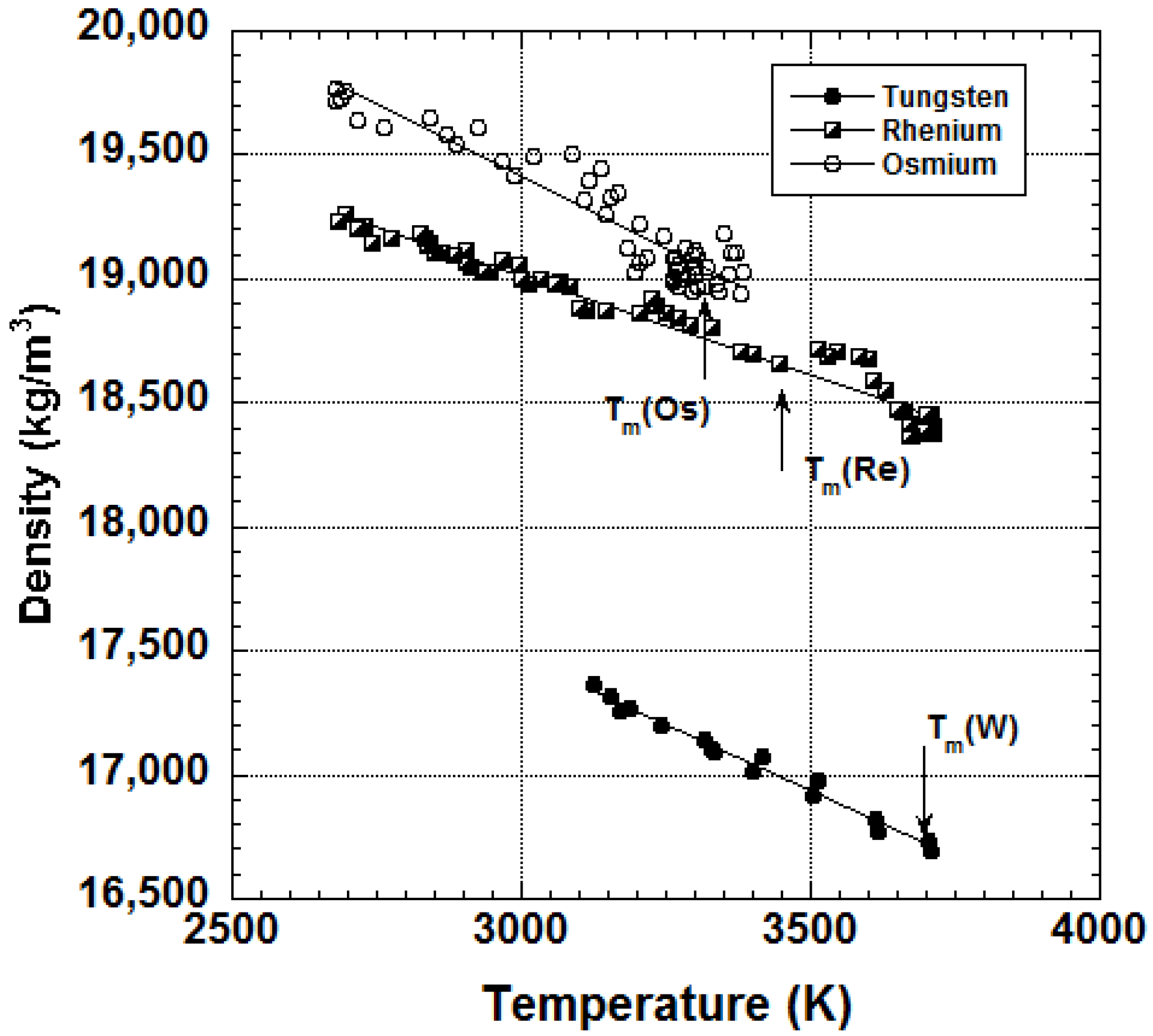Challenges of Handling, Processing, and Studying Liquid and Supercooled Materials at Temperatures above 3000 K with Electrostatic Levitation
Abstract
:1. Introduction
2. New Procedures and Technological Innovations
2.1. Electrostatic Levitaiton Furnace
2.2. Handling of Samples with Smaller Diameter
2.3. Laser Heating and Electrode Configuration
2.4. Levitation Initiation (Hot Launch)
2.5. UV Imaging
3. Typical Experimental Results
3.1. Density
3.2. Surface Tension and Viscosity
3.3. Uncertainty
3.4. Evaporation
4. Conclusions
Acknowledgments
Author Contributions
Conflicts of Interest
References
- Rhim, W.-K.; Chung, S.-K.; Barber, D.; Man, K.-F.; Gutt, G.; Rulison, A.; Spjut, R.E. An electrostatic levitator for high-temperature containerless materilas processing in 1-g. Rev. Sci. Instrum. 1993, 64, 2961–2970. [Google Scholar]
- Chung, S.-K.; Thiessen, D.B.; Rhim, W.-K. A noncontact measurement technique for the density and thermal expansion coefficient of solid and liquid metals. Rev. Sci. Instrum. 1996, 67, 3175–3181. [Google Scholar] [CrossRef]
- Rhim, W.-K.; Ohsaka, K.; Paradis, P.-F.; Spjut, R.E. Noncontact technique for measuring surface tension and viscosity of molten materials using high temperature electrostatic levitation. Rev. Sci. Instrum. 1999, 70, 2796–2801. [Google Scholar] [CrossRef]
- Rulison, A.A.; Rhim, W.-K. A noncontact measurement technique for the specific heat and total hemispherical emissivity of undercooled refractory materials. Rev. Sci. Instrum. 1994, 65, 695–700. [Google Scholar] [CrossRef]
- Rhim, W.-K.; Ishikawa, T. Noncontact electrical resistivity measurement technique for molten metals. Rev. Sci. Instrum. 1998, 69, 3628–3633. [Google Scholar] [CrossRef]
- Rustan, G.E.; Spyrison, N.S.; Kreyssig, A.; Prozorov, R.; Goldman, A.I. Noncontact technique for measuring the electrical resistivity and magnetic susceptibility of electrostatically levitated materials. Rev. Sci. Instrum. 2012, 83, 103907. [Google Scholar] [CrossRef] [PubMed]
- Gangopadhyay, A.K.; Lee, G.W.; Kelton, K.F.; Rogers, J.R.; Goldman, A.I.; Robinson, D.S.; Rathz, T.J.; Hyers, R.W. Beamline electrostatic levitator for in situ high energy x-ray diffraction studies of levitated solids and liquids. Rev. Sci. Instrum. 2005, 76, 073901. [Google Scholar] [CrossRef]
- Kordel, D.; Holland-Moritz, D.; Yang, F.; Peters, J.; Unruh, T.; Hansen, T.; Meyer, A. Neutron scattering experiments on liquid droplets using electrostatic levitation. Phys. Rev. B 2011, 83, 104205. [Google Scholar] [CrossRef]
- Aoki, H.; Paradis, P.-F.; Ishikawa, T.; Aoyama, T.; Masaki, T.; Yoda, S. Development of an electrostatic levitator for neutron diffraction structure analysis. Rev. Sci. Instrum. 2003, 74, 1147–1149. [Google Scholar] [CrossRef]
- Hyers, R.W.; Rogers, J.R. A review of electrostatic levitation for materials research. High Temp. Mater. Process. 2008, 27, 461–474. [Google Scholar] [CrossRef]
- Paradis, P.-F.; Ishikawa, T.; Lee, G.W.; Holland-Moritz, D.; Brillo, J.; Rhim, W.-K.; Okada, J.T. Materials properties measurements and particle beam interactions studies using electrostatic levitation. Mater. Sci. Eng. R 2014, 76, 1–53. [Google Scholar] [CrossRef]
- Ishikawa, T.; Paradis, P.-F. Development of Ground-based Electrostatic Levitation Furnace (in Japanese). J. Jpn. Soc. Microg. Appl. 2001, 18, 106–115. [Google Scholar]
- Paradis, P.-F.; Ishikawa, T.; Yoda, S. Development of an electrostatic levitation furnace for the ISS: Status of its ground-based thermophysical and structural properties determination capabilities. In Proceedings of the First International Symposium on Microgravity Research & Applications in Physical Sciences & Biotechnology, Sorrento, Italy, 10–15 September 2000. [Google Scholar]
- Melting, boiling, triple, and critical points of the elements. In CRC Handbook of Chemistry and Physics, 97th ed.; Haynes, W.M. (Ed.) CRC Press: Boca Raton, FL, USA, 2016–2017; pp. 4–116, 117. [Google Scholar]
- Klein, S.; Holland-Moritz, D.; Herlach, D.M. Crystal nucleation in undercooled liquid zirconium. Phys. Rev. B 2009, 80, 212202. [Google Scholar] [CrossRef]
- Ishikawa, T.; Ito, Y.; Okada, J.T.; Paradis, P.-F.; Watanabe, Y.; Masaki, T. Spectral emissivity measurements of liquid refractory metals by spectrometers combined with an electrostatic levitator. Meas. Sci. Tech. 2012, 23, 125602. [Google Scholar] [CrossRef]
- Paradis, P.-F.; Ishikawa, T.; Yoda, S. Electrostatic levitation research and development at JAXA: Past and present activities in thermophysics. Inter. J. Thermophys. 2005, 26, 1031–1049. [Google Scholar] [CrossRef]
- Rhim, W.-K.; Paradis, P.-F. Laser-induced rotation of a levitated sample in vacuum. Rev. Sci. Instrum. 1999, 70, 4652–4655. [Google Scholar] [CrossRef]
- Paradis, P.-F.; Ishikawa, T.; Koike, N. Physical properties of equilibrium and non-equilibrium liquid osmium measured by levitation techniques. J. Appl. Phys. 2006, 100, 103523. [Google Scholar] [CrossRef]
- Paradis, P.-F.; Ishikawa, T.; Fujii, R.; Yoda, S. Thermophysical properties of molten tungsten measured with an electrostatic levitator. Heat Transf. Asian Res. 2006, 35, 152–164. [Google Scholar] [CrossRef]
- Ishikawa, T.; Paradis, P.-F.; Yoda, S. New sample levitation initiation and imaging techniques for the processing of refractory metals with an electrostatic levitator furnace. Rev. Sci. Instrum. 2001, 72, 2490–2495. [Google Scholar] [CrossRef]
- Cagran, C.; Brunner, C.; Seifter, A.; Pottlacher, G. Liquid-phase behaviour of normal spectral emissivity at 684.5 nm of some selected metals. High Temp. High Press 2002, 34, 669–679. [Google Scholar] [CrossRef]
- Paradis, P.-F.; Ishikawa, T.; Fujii, R.; Yoda, S. Physical properties of liquid and undercooled tungsten by levitation techniques. Appl. Phys. Lett. 2005, 86, 041901. [Google Scholar] [CrossRef]
- Ishikawa, T.; Okada, J.T.; Paradis, P.-F.; Watanabe, Y. Thermophysical property measurements of high temperature melts using an electrostatic levitation method. JJAP 2011, 50, 11RD03. [Google Scholar]
- Pottlacher, G. High Temperature Thermophysical Properties of 22 Pure metals; Edition Keiper: Graz, Austria, 2010; ISBN 978–3-9502761–6-9. [Google Scholar]
- Calverley, A. A determination of the surface tension of liquid tungsten by the drop-weight method. Proc. Phys. Soc. 1957, 70, 1040. [Google Scholar] [CrossRef]
- Lang, G. Density of liquid elements. In CRC Handbook of Chemistry and Physics, 72nd ed.; Lide, D.R., Ed.; CRC Press: Boca Raton, FL, USA, 1991–1992; pp. 4–124. [Google Scholar]
- Allen, B.C. The surface tension of liquid transition metals at their melting points. Trans. AIME 1963, 277, 1175–1183. [Google Scholar]
- Shaner, J.W.; Gathers, G.R.; Minichino, C. A new apparatus for thermophysical measurements above 2500K. High Temp. High Press 1976, 8, 425–429. [Google Scholar]
- Seydel, U.; Kitzel, W. Thermal volume expansion of liquid Ti, V, Mo, Pd and W. J. Phys. F Metal Phys. 1979, 9, L153–L160. [Google Scholar] [CrossRef]
- Berhault, A.; Arles, L.; Matricon, J. High-pressure, high temperature thermophysical measurements on tantalum and tungsten. Int. J. Thermophys. 1986, 7, 167–179. [Google Scholar] [CrossRef]
- Steinberg, D.J. A simple relationship between temperature dependence of the density of liquid metals and their boiling temperatures. Met. Trans. 1974, 5, 1341–1343. [Google Scholar] [CrossRef]
- Sauerland, S.; Lohofer, G.; Egry, I. Surface tension measurement on levitated liquid metal drops. J. Non Cryst. Solids 1993, 156–158, 833. [Google Scholar] [CrossRef]
- Lord Rayleigh, J.S.W. On the capillary phenomena of jets. Proc. R. Soc. 1879, 29, 71–97. [Google Scholar] [CrossRef]
- Lamb, H. Hydrodynamics, 6th ed.; Cambridge University Press: Cambridge, UK, 1932; pp. 473–639. [Google Scholar]
- Ishikawa, T.; Paradis, P.-F.; Yoda, S. Noncontact surface tension and viscosity measurements of rhenium in the liquid and undercooled states. Appl. Phys. Lett. 2004, 85, 5866–5868. [Google Scholar] [CrossRef]
- Iida, T.; Guthrie, R.I. The Physical Properties of Liquid Metals; Claredon Press: Oxford, UK, 1988; p. 129. [Google Scholar]
- Keene, B.J. Review of data for the surface tension of pure metals. Int. Mat. Rev. 1993, 38, 157–192. [Google Scholar] [CrossRef]
- Vinet, B.; Magnusson, L.; Fredriksson, H.; Desre, P.J. Correlations between surface and interface energies with respect to crystal nucleation. J. Colloid Interface Sci. 2002, 255, 363–374. [Google Scholar] [CrossRef]
- Ishikawa, T.; Paradis, P.-F.; Okada, J.; Kumar, M.V.; Watanabe, Y. Viscosity of molten Mo, Ta, Os, Re, and W measured by electrostatic levitation. J. Chem. Thermodyn. 2013, 65, 1–6. [Google Scholar] [CrossRef]
- Andrade, E.N.da C. A theory of the viscosity of liquids. —Part II. Philos. Mag. 1934, 17, 698. [Google Scholar] [CrossRef]
- Bradshaw, R.C.; Schmidt, D.P.; Rogers, J.R.; Kelton, K.F.; Hyers, R.W. Machine vision for high-precision volume measurement applied to levitated containerless material processing. Rev. Sci. Instrum. 2005, 76, 125108. [Google Scholar] [CrossRef]
- Yoo, H.; Park, C.; Jeon, S.; Lee, S.; Lee, G.W. Uncertainty evaluation for density measurements of molten Ni, Zr, Nb and Hf by using a containerless method. Metrologia 2015, 52, 677–684. [Google Scholar] [CrossRef]
- Ishikawa, T.; Paradis, P.-F.; Fujii, R.; Saita, Y.; Yoda, S. Thermophysical Property Measurements of Liquid and Supercooled Iridium by Containerless Methods. Int. J. Thermophys. 2005, 26, 893–904. [Google Scholar] [CrossRef]
- Ishikawa, T.; Okada, J.T.; Murakami, K.; Ogawa, S.; Koshikawa, N.; Shibasaki, K.; Yamaura, Y.; Takada, T. Development of the electrostatic levitation furnace (ELF) for the International Space Station (ISS). J. Jpn. Soc. Microg. Appl. 2010, 27, 199–204. (In Japanese) [Google Scholar]
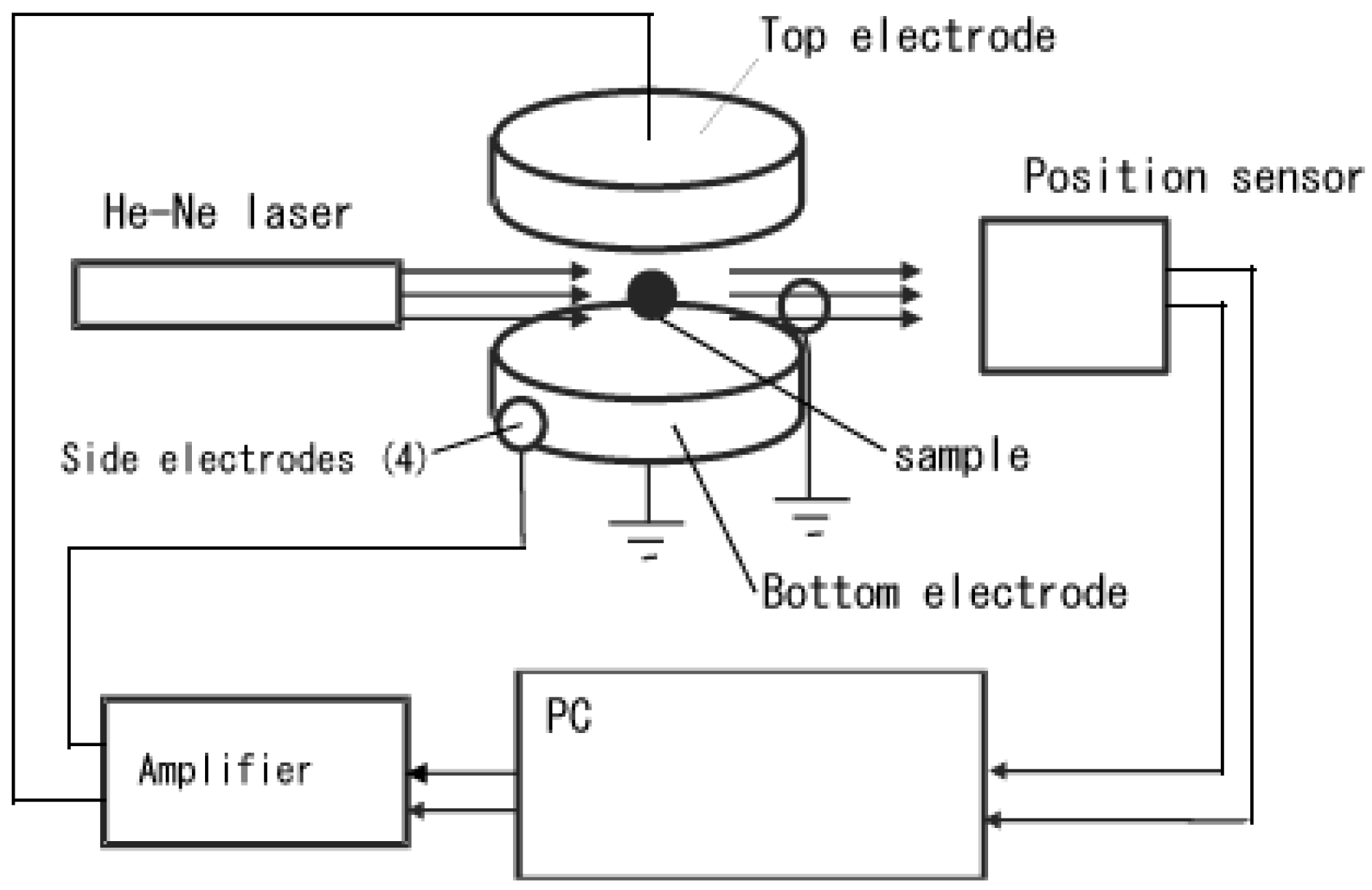
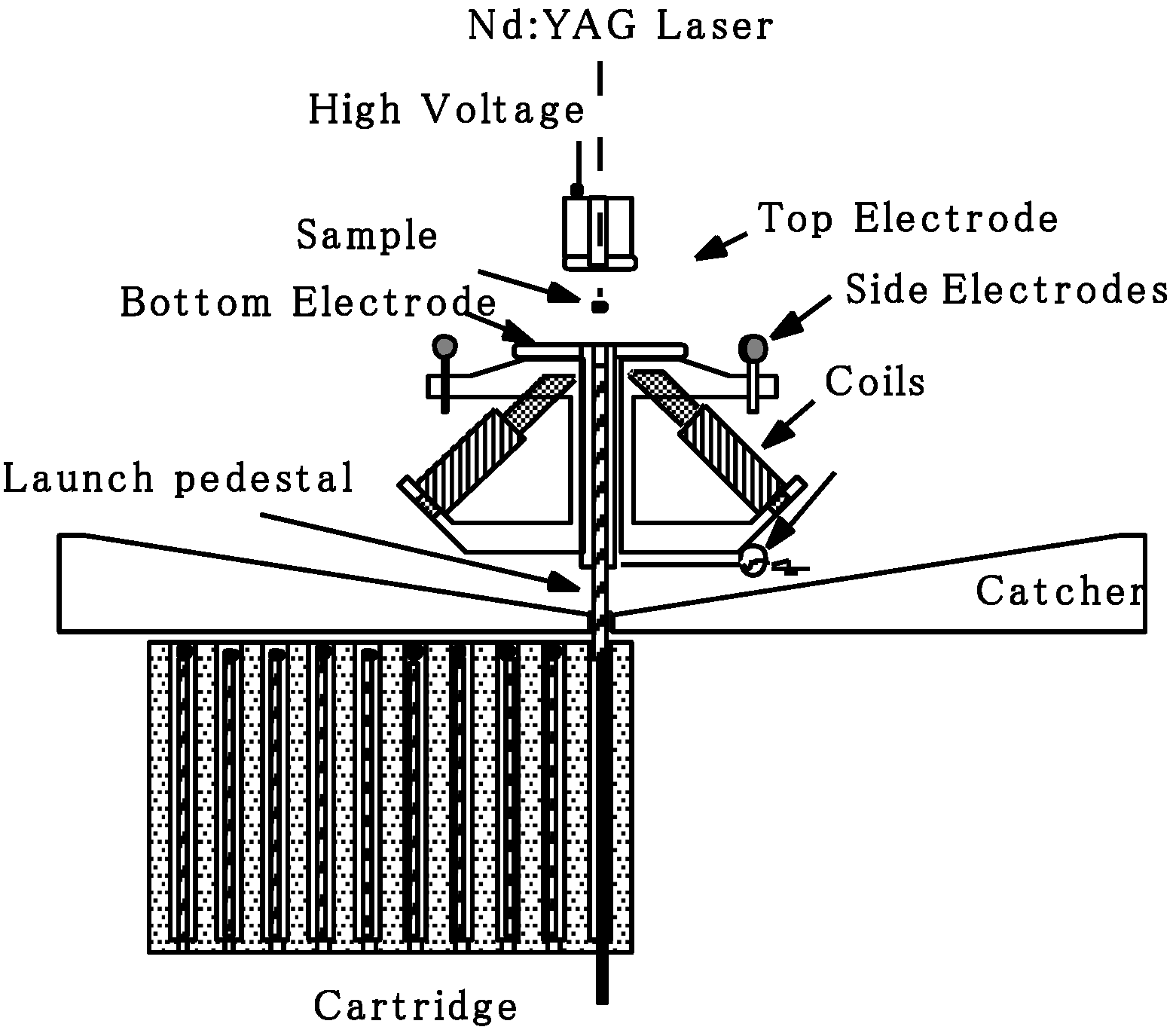
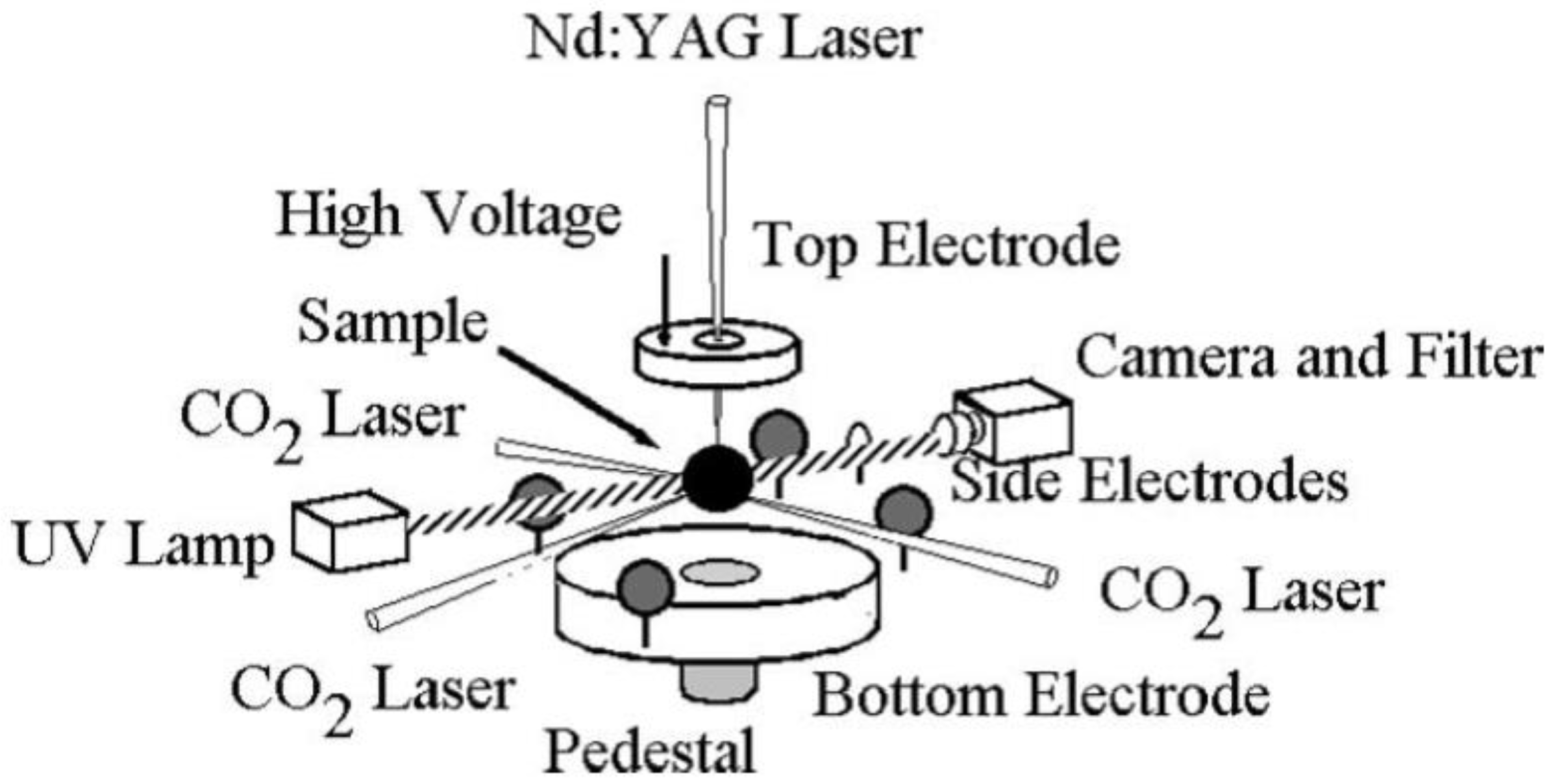
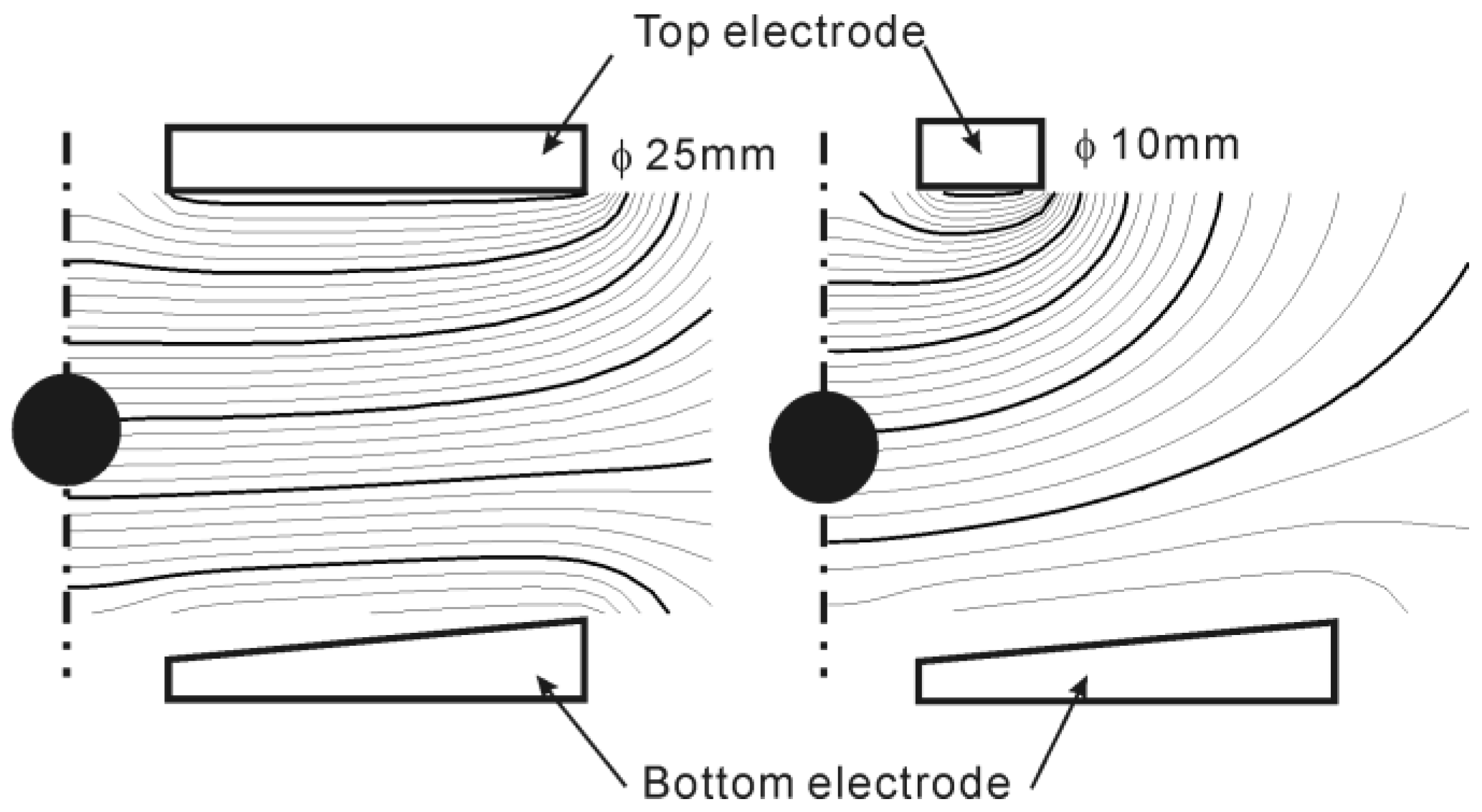
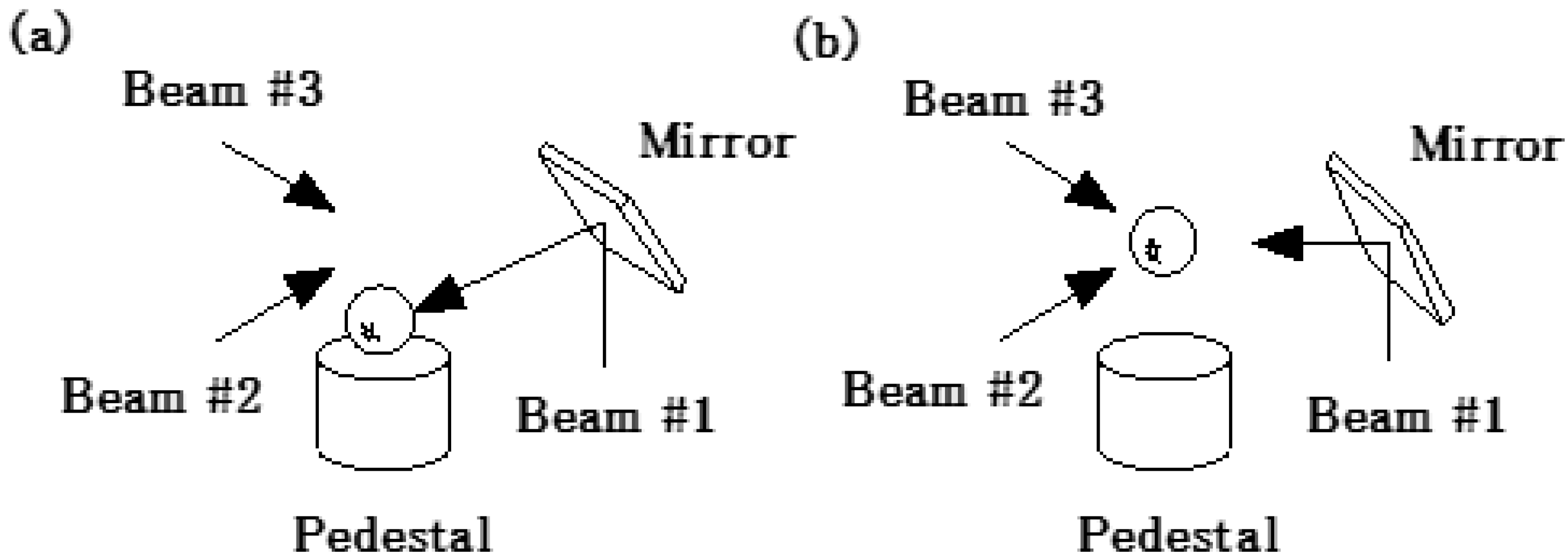
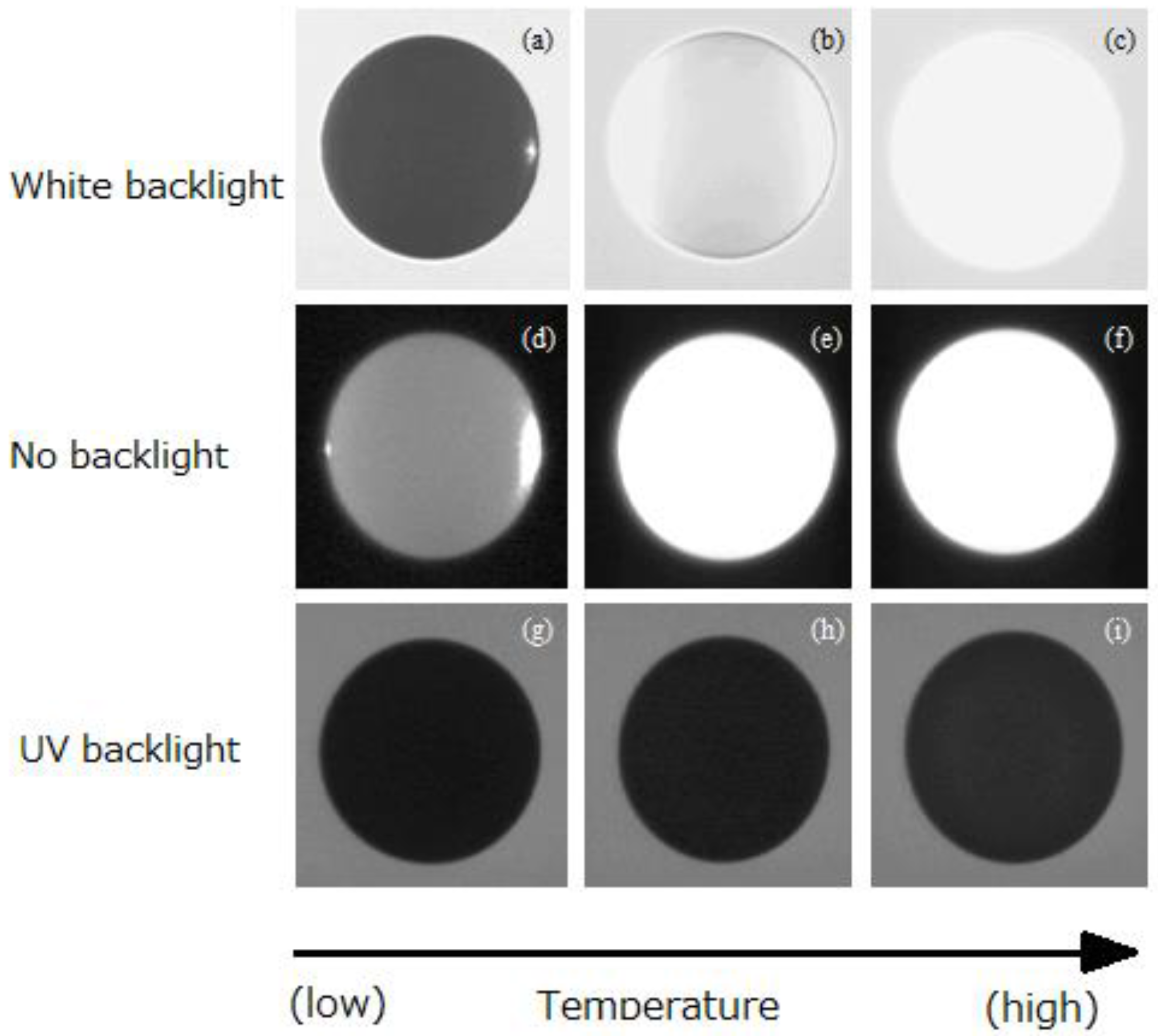

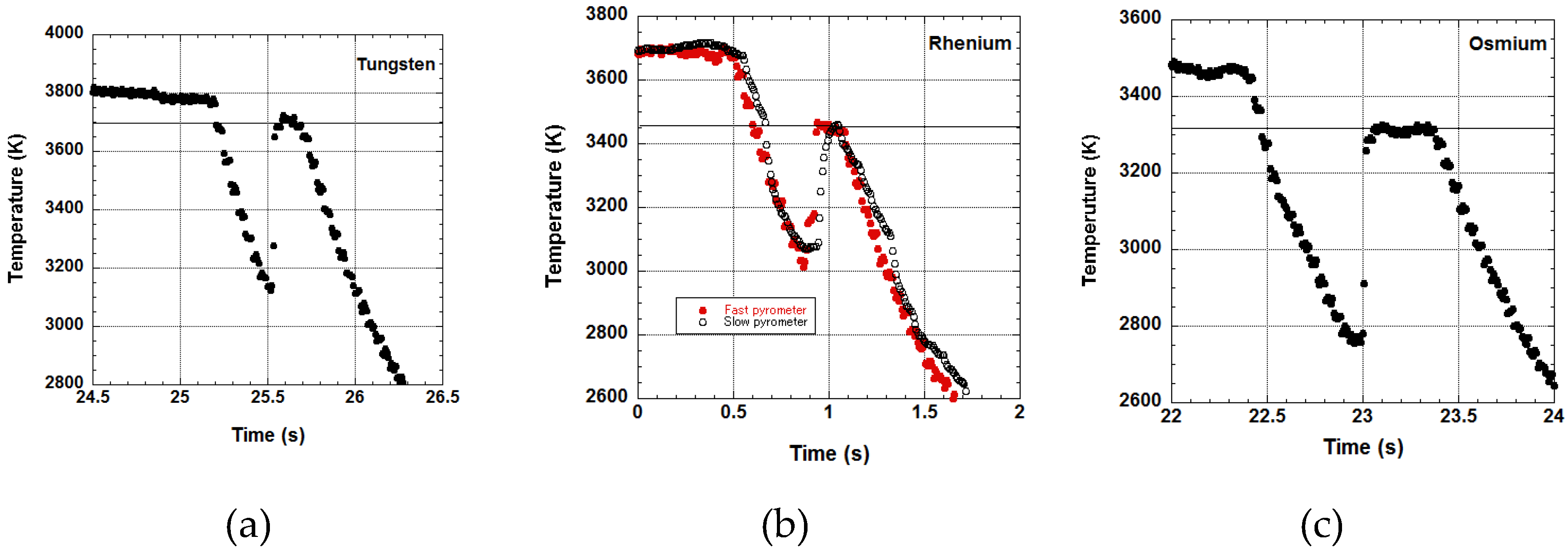
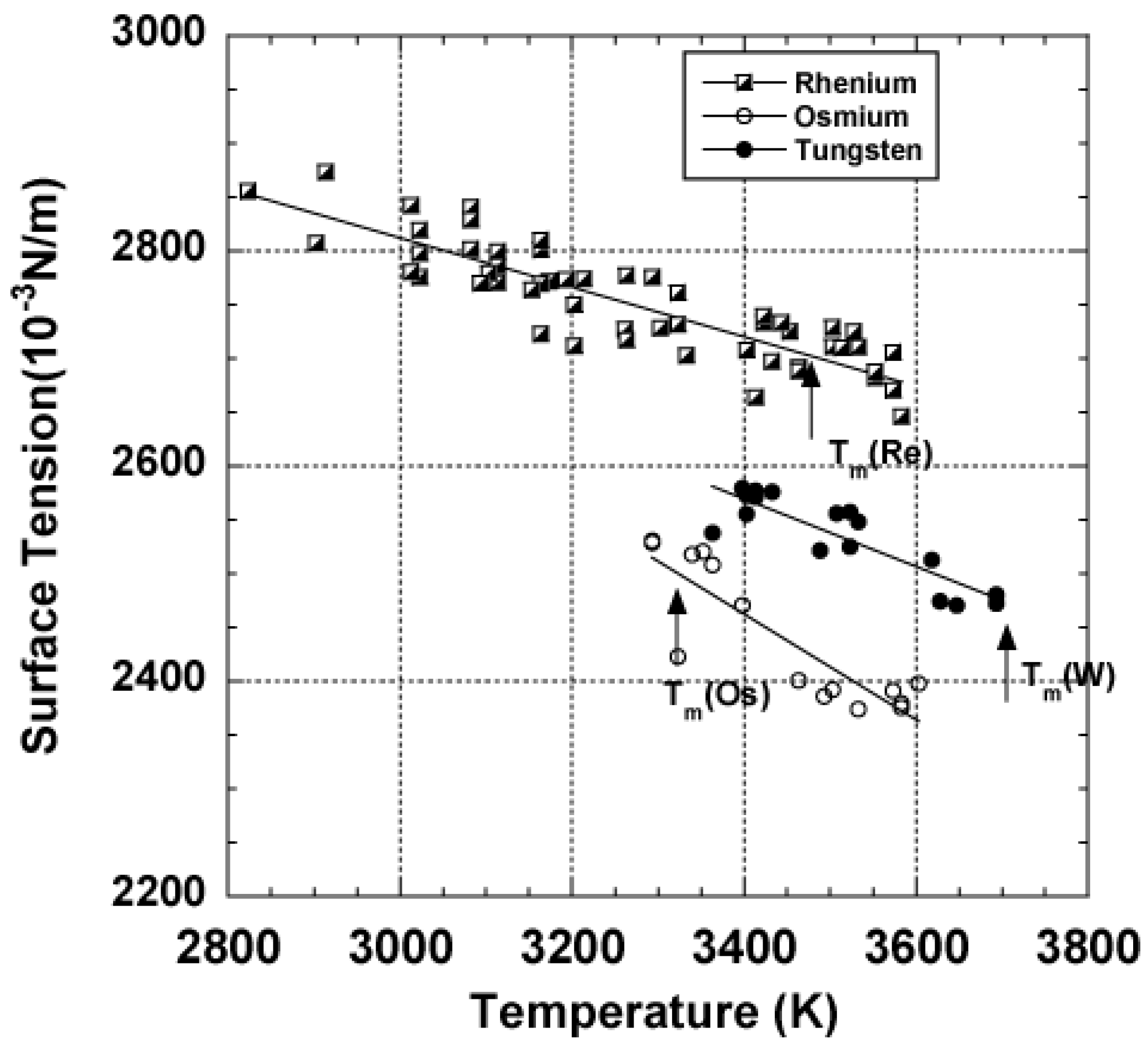
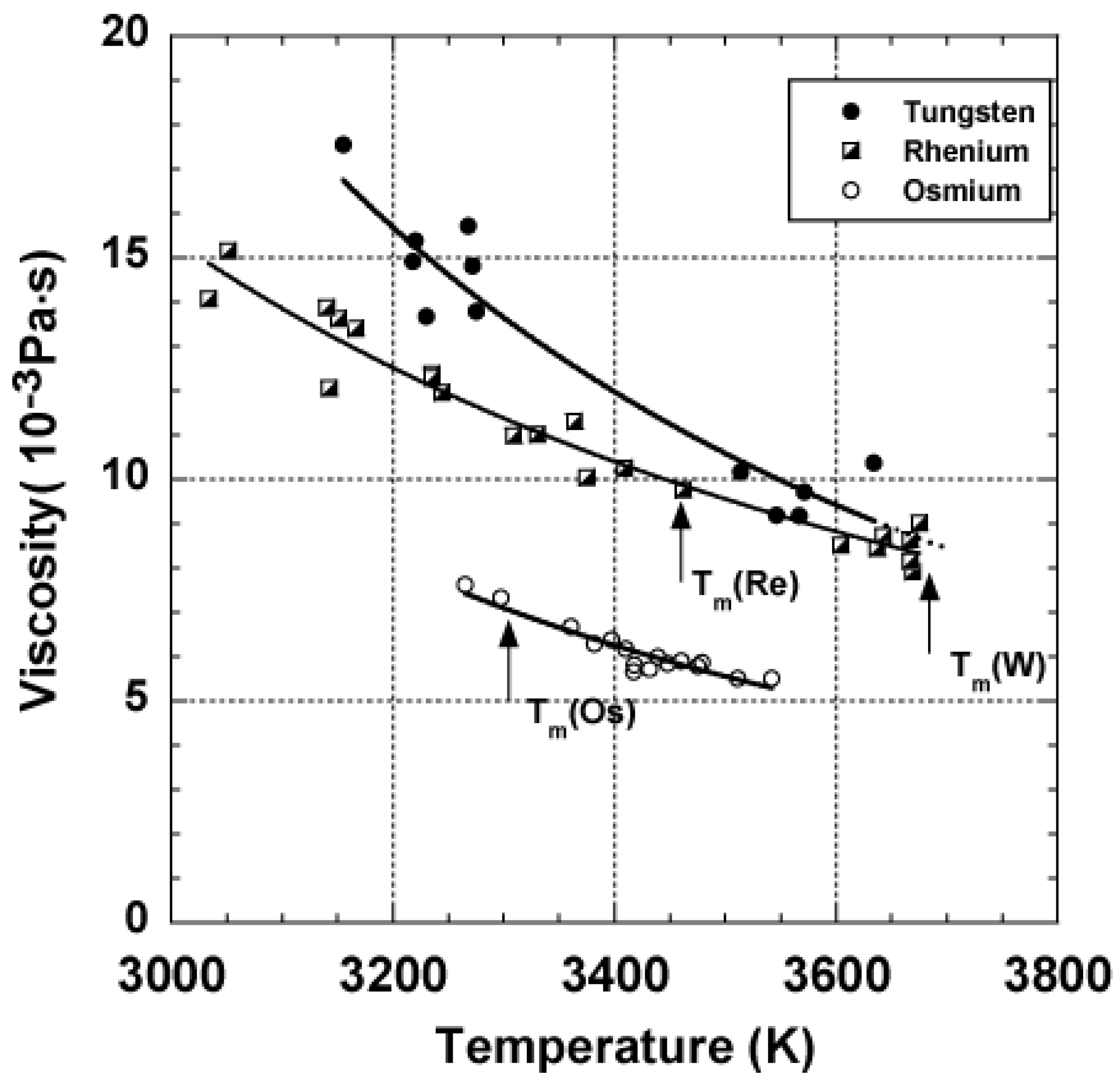
| Sample Mass (mg) | Sample Diameter (mm) | Voltage (kV) | Melting Temperature (K) | |
|---|---|---|---|---|
| W | 30–50 | 1.5–1.6 | 20–21 | 3687 |
| Re | 45–85 | 1.6–2.0 | 13–17 | 3458 |
| Os | 30–60 | 1.5–1.8 | 20–22 | 3306 |
| Zr | 16–34 | 1.7–2.2 | 8.5–11.5 | 2127 |
| Density @Tm (×103 kg·m−3) | Temperature Coefficient (kg·m−3·K−1) | Method | Author | |
|---|---|---|---|---|
| W | 16.7 | −1.08 | Levitation | Present work [23] |
| 17.6 | – | Calculation | Calverey [26] | |
| 17.7 | – | – | Pekarev [27] | |
| 17.5 | – | Calculation | Allen [28] | |
| 16.26 | – | Pulse heating | Shaner et al. [29] | |
| 16.37 | – | Pulse heating | Seydel and Kitzel [30] | |
| 16.2 | – | Pulse heating | Berhault et al. [31] | |
| – | −0.79 | Calculation | Steinberg [32] | |
| Re | 18.65 | −0.79 | Levitation | Present work [24] |
| 18.9 | – | – | Pekarev [27] | |
| 18.7 | – | Calculation | Allen [28] | |
| 18.0 | – | Isobaric expansion | Thevenin [29] | |
| – | −0.82 | Calculation | Steinberg [32] | |
| Os | 19.1 | −1.16 | Levitation | Present work [19] |
| 19.2 | – | Calculation | Allen [28] |
| Surface tension @Tm (×10−3 N·m−1) | Temperature Coefficient (N·m−1·K−1) | Method | Author | |
|---|---|---|---|---|
| W | 2477 | −0.31 | Levitation | Present work [20] |
| 2330 | – | Pendant drop/Drop weight | Calverley [26] | |
| 2500 | – | Pendant drop/Drop weight | Allen [28] | |
| 2220 | – | Pendant drop/Drop weight | Pekarev [38] | |
| 2316 | – | Pendant drop/Drop weight | Martsenyuk [38] | |
| 2300 | – | Pendant drop/Drop weight | Agaev [38] | |
| 2310 (@3680 K) | – | Pendant drop/Drop weight | Vinet [9] | |
| Re | 2710 | −0.23 | Levitation | Present work [36] |
| 2610 | – | Pendant drop/Drop weight | Pekarev [38] | |
| 2700 | – | Pendant drop/Drop weight | Allen [28] | |
| 2520 (@ 3440 K) | – | Pendant drop/Drop weight | Vinet [39] | |
| Os | 2480 | −0.34 | Levitation | Present work [19] |
| 2500 | – | Pendant drop/Drop weight | Allen [28] |
| Viscosity @Tm (×10−3·Pa·s) | η = η0exp(E/RT) | Method | Author | ||
|---|---|---|---|---|---|
| η0 (×10−3 Pa·s) | E (J·mol−1) | ||||
| W | 8.5 | 0.16 | 122 | Levitation | Present work [40] |
| Re | 9.9 | 0.54 | 83.7 | Levitation | Present work [40] |
| Os | 7.0 | 0.098 | 111.5 | Levitation | Present work [40] |
| Temperature Range (K) | Duration of Experiment (s) | Loss of Mass (mg) | Evaporation Rate (mg/s) | ||
|---|---|---|---|---|---|
| W | Run#1 | 3363–3693 | 445 | 12.2 (44.2 to 32.0) | 0.027 |
| Run#2 | 3693 | 30 | 0.9 (43.0 to 42.1) | 0.03 | |
| Run#3 | 3398–3573 | 168 | 2.8 (50.8 to 48.0) | 0.016 | |
| Re | Run#1 | 2903–3463 | 413 | 4.2 (47.6 to 43.4) | 0.010 |
| Run#2 | 2823–3467 | 516 | 6.9 (85.5 to 78.6) | 0.013 | |
| Os | Run#1 | 3418–3511 | 203 | 15.2 (60.9 to 45.7) | 0.075 |
| Run#2 | 3323–3603 | 213 | 15.7 (47.0 to 31.3) | 0.074 |
© 2017 by the authors. Licensee MDPI, Basel, Switzerland. This article is an open access article distributed under the terms and conditions of the Creative Commons Attribution (CC BY) license (http://creativecommons.org/licenses/by/4.0/).
Share and Cite
Ishikawa, T.; Paradis, P.-F. Challenges of Handling, Processing, and Studying Liquid and Supercooled Materials at Temperatures above 3000 K with Electrostatic Levitation. Crystals 2017, 7, 309. https://doi.org/10.3390/cryst7100309
Ishikawa T, Paradis P-F. Challenges of Handling, Processing, and Studying Liquid and Supercooled Materials at Temperatures above 3000 K with Electrostatic Levitation. Crystals. 2017; 7(10):309. https://doi.org/10.3390/cryst7100309
Chicago/Turabian StyleIshikawa, Takehiko, and Paul-François Paradis. 2017. "Challenges of Handling, Processing, and Studying Liquid and Supercooled Materials at Temperatures above 3000 K with Electrostatic Levitation" Crystals 7, no. 10: 309. https://doi.org/10.3390/cryst7100309





